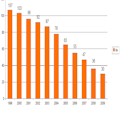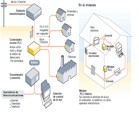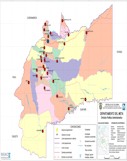| |
|
Summary |
|
|
| |
|
What is CITEL? |
|
|
| |
|
Links |
|
|
| |
|
Information |
|
|
| |
| |
|
| |
|
Upcoming events |
|
IPv6 – Unified Future
By Oscar Messano, Rapporteur, Group on issues
relative to Internet resources |
|
 On
July 8, a tutorial on IPV6 in Spanish will be done
through Internet for Member States and Associate
members of PCC.I. The tutorial for English took
place on April 21, 2009. The agenda includes:
Resources of Internet (Internet Regional registries,
Development
of Policies, Present distribution of addresses),
Levels of decision and the role of governments, the
private sector and registries. On
July 8, a tutorial on IPV6 in Spanish will be done
through Internet for Member States and Associate
members of PCC.I. The tutorial for English took
place on April 21, 2009. The agenda includes:
Resources of Internet (Internet Regional registries,
Development
of Policies, Present distribution of addresses),
Levels of decision and the role of governments, the
private sector and registries. |
|
more information |
|
|
Important issues |
|
|
Key VoIP Issues |
|
|
Relatively new services are arising in the
telecommunications environment. One such case is IP
Telephony, which has drawn the attention of
regulators, the industry and consumers particularly
because of its characteristics, which have increased
the service alternatives that can be provided
through the Internet Protocol compared to
switched-circuit telephone networks. |
|
more information |
|
Architecture of a PLC access network
By Josefina Cano, Rapporteur, Group on
Network Infrastructure |
|

The features of a PLC access network architecture
are:
• Bus network topology, meaning
the bandwidth provided by each transformer is shared
by all the users connected to it
• Any electric outlet in the
house will be a communication port as long as it has
a PLC modem, which incorporates two filters to
separate the carrier signals (High-pass Filter) from
the electric current signals (Low-pass Filter).
• There are distance limitations
both for the internal section to the household and
the access section: these are approximately 400
meters for the access section and 50 meters for the
internal section within the home.
• The access controller or PLC
Headend modem is in charge of connecting the various
service networks (Internet, television, telephony)
with the low-voltage line. |
|
more information |
|
Comprehensive
telemedicine system in Department of Meta, Colombia
By Karim Nader y Daniel Rosas Tapia , TES
America |
|
Successful implementation of the first integrated
telemedicine s ystem
in the department of Meta, Colombia. The system,
which began operating in April 2009, interconnects
29 municipalities in rural areas using fixed
satellite service. The main objectives are: ystem
in the department of Meta, Colombia. The system,
which began operating in April 2009, interconnects
29 municipalities in rural areas using fixed
satellite service. The main objectives are:
To design and implement an integrated solution to
facilitate delivery of specialized medical diagnosis
services to 28 rural municipalities by the main
hospital located in the departmental capital
(Villavicencio).
To generate the greatest possible
social impact by maximizing the existing resources
in each hospital and taking into account the most
frequent diseases in the department.
To promote use of the system and
train medical and support staff from the
Villavicencio hospital and the 28 municipalities. |
|
more information |
|
|
Training |
|
The IP address
By Roberto Rossi, Universidad Blas Pascal |
|
 The
IP protocol identifies each computer connected to
the network by its corresponding address. This
address is a 32 bits number in Ipv4, that has to be
unique for each server or computer, which we will
call “host”. The IP addresses are usually
represented as four decimal ciphers, of 8 bits each,
separated by dots. The
IP protocol identifies each computer connected to
the network by its corresponding address. This
address is a 32 bits number in Ipv4, that has to be
unique for each server or computer, which we will
call “host”. The IP addresses are usually
represented as four decimal ciphers, of 8 bits each,
separated by dots. |
|
more information |
|
|
What's happening in the
region? |
|
|
Colombia: Now has Information and Communication
Technology Law |
|
|
The ICT Law, which regulates Information and
Communication Technologies in Colombia, was passed
by Congress today. It culminates years of effort by
the Ministry of Communications and the industry to
regulate the regulatory distribution and establishes
an institutional framework for information and
communications technologies. "I am very pleased with
the work done by the senators, representatives, the
Ministry of Communications team, organizations,
operators, and various sectors that helped to make
this law a reality, putting in place a coherent
legislative framework for the sector, and, as former
British Prime Minister Winston Churchill said, when
we insist, persist, resist, and do not desist, we
achieve our objectives. This is what happened with
the ICT law,” Minister of Communications María del
Rosario Guerra remarked. (Minister of
Communications, 19 June 2009) |
|
more information |
|
|
Brazil: Anatel publishes five consultations on
radio frequencies |
|
|
The National Telecommunication Agency (Anatel)
hereby submits for public comment and suggestions
some consultations related to allocation,
channeling, and terms of use of radio frequency
spectrum.
Public Consultation 21 – opens for comment the
proposed secondary allocation of the radio frequency
on the 401.57 MHz to 401.7 MHz band for Fixed and
Mobile Services, except aeronautical mobile and
secondary allocation of the 401.57 MHz to 401.7 MHz
and 465.9725 MHz to 466.0025 MHz bands to
Specialized Limited Service (SLS).
Public Consultation 22 – submits for public
evaluation proposed Regulations on Channeling and
Terms of Use of the 360 MHz to 380 MHz Radio
Frequency Band.
Public Consultation 23 – contains proposed
Regulations on Channeling and Terms of Use of the
380 MHz to 400 MHz Radio Frequency Band.
Public Consultation 24 – contains proposed
Regulations on Channeling and Terms of Use of the
450 MHz to 470 MHz Radio Frequency Band.
Public Consultation 25 – contains proposed
Regulations on Channeling and Terms of Use of the
225 MHz to 270 MHz Radio Frequency Band.
(Anatel, 16 June 2009) |
|
more information |
|
|
Colombia: Communications Ministry invested
$12,675 million in Meta Digital strategy in 2008 |
|
|
Telemedicine Services, an interactive portal for
agricultural enterprises and for processing school
enrollment via the web, are just a few of the
services launched by the Minister of Communication,
María del Rosario Guerra, as part of the Meta
Digital initiative. In 2008, the Ministry of
Communications invested some 12,675 million pesos in
this strategy. (Ministry of Communications, 12 June
2009) |
|
more information |
|
|
United States of America: Digital signals for
terrestrial television broadcasting |
|
|
By midnight on June 12, 2009, all of the more than
1,600 full-power U.S. television stations will cease
broadcasting analog NTSC signals and will rely
entirely on their ATSC digital signals for
terrestrial television broadcasting to their
viewers. Digital ATSC signals have been on the air
in some cities since 1998 and in virtually all
cities since 2002, but now we are ready to turn off
the analog signals. Except for some low power
stations and translators, this will mark the end of
the transition to digital television broadcasting in
the U.S., a process that began in 1987 and led to
industry adoption of the ATSC Standard in 1995 and
FCC adoption in 1996. (12 June 2009) |
|
|
Colombia: Launches new era in
Tele-Health |
|
|

The Ministries of Communications and Social
Protection today unveiled an initiative for the
future of health service delivery using information
and Communications technologies (ICTs) on the
"Towards A Country in Tele-Health Plan” program.
Thanks to ICT tools, 790 health service delivery
institutions nation-wide are now linked up in 20 of
the country’s departments. More than 7,000
Colombians have directly benefited from telemedicine
care, that is, medical appointments in real time
over the Internet, using information and
communications technologies (ICTs). (Ministry of
Communications, 4 June 2009) |
|
more information |
| |
|
|

 On
July 8, a tutorial on IPV6 in Spanish will be done
through Internet for Member States and Associate
members of PCC.I. The tutorial for English took
place on April 21, 2009. The agenda includes:
Resources of Internet (Internet Regional registries,
On
July 8, a tutorial on IPV6 in Spanish will be done
through Internet for Member States and Associate
members of PCC.I. The tutorial for English took
place on April 21, 2009. The agenda includes:
Resources of Internet (Internet Regional registries,

 ystem
in the department of Meta, Colombia. The system,
which began operating in April 2009, interconnects
29 municipalities in rural areas using fixed
satellite service. The main objectives are:
ystem
in the department of Meta, Colombia. The system,
which began operating in April 2009, interconnects
29 municipalities in rural areas using fixed
satellite service. The main objectives are: The
IP protocol identifies each computer connected to
the network by its corresponding address. This
address is a 32 bits number in Ipv4, that has to be
unique for each server or computer, which we will
call “host”. The IP addresses are usually
represented as four decimal ciphers, of 8 bits each,
separated by dots.
The
IP protocol identifies each computer connected to
the network by its corresponding address. This
address is a 32 bits number in Ipv4, that has to be
unique for each server or computer, which we will
call “host”. The IP addresses are usually
represented as four decimal ciphers, of 8 bits each,
separated by dots.